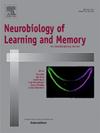饥饿对雄性和雌性小鼠避近行为的影响是不同的
IF 1.8
4区 心理学
Q3 BEHAVIORAL SCIENCES
引用次数: 0
摘要
在受到威胁的情况下,决定是接近还是避免奖励,需要平衡相互竞争的需求。性别特定的优先顺序(如交配、照顾母亲)或一般优先顺序(如喂养、饮水、睡眠)可能会根据生物体的“风险”水平和体内平衡需求状态,对避近行为产生不同的影响。然而,考虑到可能影响这种行为的关键方面已知的性别差异,尚未对雄性和雌性小鼠在禁食状态下如何决定接近或避开危险区域进行直接比较。方法我们对雄性和雌性C57BL6J小鼠进行了几种不同风险和回报水平的避近任务,这些小鼠被喂食或禁食。小鼠通过光-暗箱、高架+迷宫、诱饵大开阔地和跑道任务来评估其接近和回避行为。结果在光-暗箱和高架加迷宫中,当无奖励时,禁食的雌性小鼠比饱食的雌性小鼠表现出更大的接近行为,而雄性小鼠无差异。在有诱饵的开阔田野中,当有奖励时,两种性别在禁食时都表现出增加的接近行为。然而,当雄性小鼠饱食时,与雌性小鼠相比,雄性小鼠反而表现出更多的接近行为。在跑道任务中,虽然饱腹的老鼠没有学习,但禁食的雄性老鼠在增加的电击强度下抑制了它们的奖励消耗;然而,禁食的雌性小鼠对增加的电击强度有抵抗力。结论我们的研究发现了小鼠决策行为的性别差异,这是基于在几个避近任务中的饱足状态。我们强调了基于奖励可用性和惩罚强度的这些差异的几个细微差别。这些结果揭示了两性在先天和生存驱动行为上的根本差异,这些差异应该在未来的研究中得到考虑。本文章由计算机程序翻译,如有差异,请以英文原文为准。
Hunger alters approach-avoidance behaviours differently in male and female mice
Background
The decision about whether to approach or avoid a reward while under threat requires balancing competing demands. Sex-specific prioritisations (e.g. mating, maternal care), or generalised prioritisations (e.g. feeding, drinking, sleeping) may differently influence approach-avoidance behaviours based on the level of “risk” and homeostatic need state of the organism. However, given known sex differences in key aspects that may influence this behaviour, direct comparison of how male and female mice make decisions to approach or avoid a dangerous area while in a fasted state have yet to be conducted.
Methods
We conducted several approach-avoidance tasks with varied levels of risk and reward in male and female C57BL6J mice that were either fasted or sated (fed). Mice underwent a light–dark box, elevated plus maze, baited large open field and runway task to assess their approach and avoidance behaviour.
Results
In the light–dark box and elevated plus maze, when no reward was available, fasted female mice showed greater approach behaviours than sated counterparts, while no difference was observed in males. In the baited large open field, when reward was available, both sexes showed increased approach behaviours when fasted. However, when sated, male mice conversely showed greater approach behaviours compared to sated female mice. In the runway task, while sated mice failed to learn, fasted male mice inhibited their reward consumption in response to increased shock intensity; however, fasted female mice were resistant to increased shock intensity.
Conclusions
Our study identifies sex differences in decision making behaviour in mice based on satiety state across several approach-avoidance tasks. We highlight several nuances of these differences based on reward availability and punishment intensity. These results shine a lens on fundamental differences between the sexes in innate, survival driven behaviours that should be considered for future studies.
求助全文
通过发布文献求助,成功后即可免费获取论文全文。
去求助
来源期刊
CiteScore
5.10
自引率
7.40%
发文量
77
审稿时长
12.6 weeks
期刊介绍:
Neurobiology of Learning and Memory publishes articles examining the neurobiological mechanisms underlying learning and memory at all levels of analysis ranging from molecular biology to synaptic and neural plasticity and behavior. We are especially interested in manuscripts that examine the neural circuits and molecular mechanisms underlying learning, memory and plasticity in both experimental animals and human subjects.

 求助内容:
求助内容: 应助结果提醒方式:
应助结果提醒方式:


